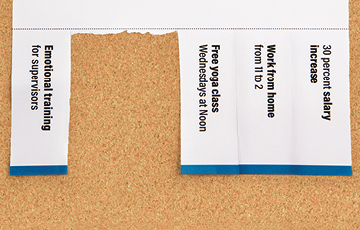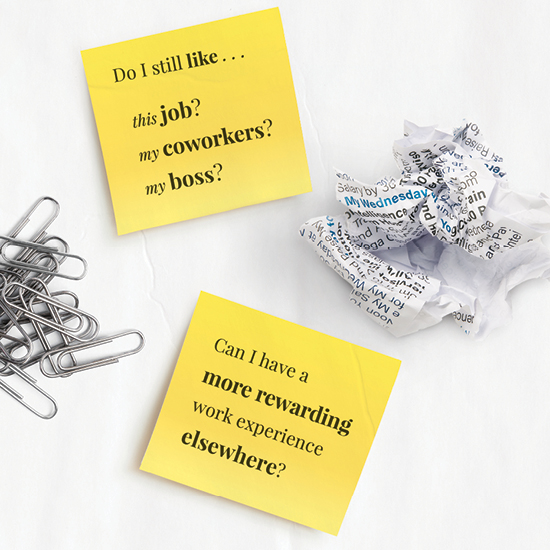Take This Job
Employers face a new set of challenges as workers decide to take their work life into their own hands
If LinkedIn notified you that you appeared in 37 searches this week, you’re not alone. Businesses are hiring. Over the course of 2021, on average, nearly four million people quit their jobs every month in the United States.
While not everyone who stepped away did so in search of a new beginning—a portion of the people who left the workforce were retiring baby boomers—the numbers were significant nonetheless. Retirees aside, agreement is widespread that the pandemic is the overarching force behind the workplace flight we’re calling the Great Resignation. But the ways in which the virus has affected workers vary greatly. Concerns about contracting COVID-19 and about bringing the virus home, experienced early on by essential workers, also became an issue for the many service-industry and professional workers called back to the workplace last year. Employees who had for a long time felt themselves reasonably safe at home had to confront a new risk that, even if vaccinated, was unwelcome. Organizational psychologist Lola Gershfeld (MA ’05) notes that not all business owners made a point of communicating their safety protocols, if they existed, with their staff or of listening to their worries. The fear and stress among employees at all wage levels were more than some were willing to tolerate.

Other workers, particularly women and mothers, just fell to the demands of the circumstances. Gershfeld, in her position as a corporate team counselor, helps employees manage their relationships at work. She relates speaking with one mother of two children who was also a team manager at her office. Pressured to be both at home with her kids and at work, leading her staff became overwhelming. Her supervisor’s response, advising her to “just stay positive,” did not begin to address the impossibility of being in two places at once.
Other observers agree that the pandemic created a maelstrom for women at work. The 2021 “Women in the Workplace” study by McKinsey and Co. and LeanIn.org reported that one in three women were considering either leaving their jobs or downshifting their careers. Bobbi Thomason, Graziadio assistant professor of applied behavioral science, points out that pre-COVID-19, women were already stretched thin with their parenting, home, and work responsibilities. When the pandemic hit, the basic infrastructure of their support system— school, daycare, childcare, activities—no longer existed. “Two full-time jobs, along with facilitating homeschooling, just fell brutally on working women,” she says. “What we saw in the Great Resignation was an exodus of millions of women from the workforce.”
And the need to be homeschooling while attending to business, or the need to just
take time away from work altogether, has been damaging to women’s careers. Thomason
further notes that not only has women’s participation in the workforce diminished,
but there has also been a cost to women in the leadership realm and in professional
achievement. “There have been some sobering studies on how male academics have actually
become more productive during the pandemic, and women have been less so,” she says.
Similar outcomes have been occurring in other professions where employees are largely
evaluated on their hours at their desks, such as law firms and investment banks. Jaclyn
Margolis, Graziadio associate professor of applied behavioral science, concurs that
the trajectory of many women’s careers has seen a serious setback. “Women were making
strides and getting past the broken rung that kept them from moving up the corporate
ladder, and now you see some of those trends reversing,” she says. “It is heartbreaking.”

While stress, burnout, and exhaustion make up one part of the great resignation’s
origin story, students of the phenomenon are celebrating the remarkable shift in self-determination
representing its other side. Many social scientists are calling this turn away from
the workplace the “great awakening.”
Ann Feyerherm, professor of organizational theory and management at the Graziadio School, explains that COVID-19 required everyone to work differently. Retail workers had to wear masks and gloves, and those in the medical field had to learn how to treat patients remotely or expose themselves to tremendous risks. Office workers had to figure out how to work effectively from home. Across a wide swath of occupations and income levels, people woke up to the reality that their work could be accomplished in a way that was previously unconsidered, if not unthinkable.
Along with this realization came the constant pandemic-inspired reminders, both from personal experience and from the media, that life is finite. Accordingly, says Feyerherm, workers began to ask themselves, “Do I still like this job? Do I still like my coworkers? My boss? Can I have a better, more rewarding, more accommodating work experience elsewhere?” A robust labor market, combined with a refusal to continue work as they knew it, resulted in a massive uncoupling of employees and employers.
So what do workers want now?
Of course, workers are looking for positions that provide better pay and better benefits. But they also want a supportive work environment.
A culture of caring and belonging goes far in sustaining a satisfied workforce. Gershfeld points out that employees seek both physical and psychological safety. The latter, the confidence that one can risk offering a new idea or admitting a mistake without being punished or embarrassed, is important to a fulfilling work experience. She also notes that everyone yearns for emotional connection, and when employees feel supported and, even further, allowed to be vulnerable, they work together much more effectively. They’re more creative. “When people can bring their whole selves to work, they feel more engaged in what they’re doing,” she says.
In addition to an affirming corporate culture, the need for autonomy is at the top of employees’ must-have lists. The autonomy workers are demanding is composed of two interrelated desires: 1) to work from home (or wherever they want) and 2) to have more flexibility in creating their work/life integration.
Mark Allen (MBA ’90), practitioner lecturer of organizational theory and management and academic director of the MS in human resources program at Graziadio, cites one study of individuals called back to the office last year. It found that 58 percent of workers said that they would consider quitting their jobs if they could no longer work at home. “We all learned during COVID-19 that we can work at home, and we like to work at home,” he says. Feyerherm confirms that the ability to work away from the office is at the top of many employees’ demands, as they’re making lifestyle choices that are contingent on having a long-distance career. “Now Boise, Idaho, is the country’s fastest-growing city,” she says, “because people are leaving the big cities with the plan to work remotely, and they’re not going to move back.”
Workers are reconfiguring the experience they want.
And organizations have to be a part of the dialogue.
—Zhike Lee
And while some managers question whether employees working from home (or elsewhere) are actually working, 83 percent of respondents in a 2021 OWL Labs study of more than 2,000 workers said that when working from home, they are as productive, or more so, than when in the workplace.
Workers also want to customize their work arrangements so that they meet their work/life preferences. “We can now work flexible schedules and arrange for flexible time, and a lot of people discovered that they really don’t want to go back to the traditional workweek and work schedule,” says Allen. The opportunity to create one’s own work experience, perhaps with a long break midday, or summers off altogether, or simply starting the workday a bit later in order to bring one’s child to school, are the types of accommodations that employees want to build into their lives. Margolis gives the example of an online retailer that has developed “prime time hours,” from 11 AM until 2 PM for all meetings. Employees may otherwise work during the times of day that best meet their needs. Thomason points out that although some employers have offered such accommodations in the past, people generally haven’t taken advantage of them. “They know it’s not rewarded,” she says, “and this needs to change.”
Margolis further observes that one way to obtain a perfectly bespoke career is to strike out on one’s own, and many people did just that. According to the Census Bureau, about 4.4 million new businesses were created in 2020, and 5.4 million in 2021. (For comparison, 2010 saw the establishment of 2.5 million new businesses.) Of course, some new entrepreneurs had been laid off or had worked for organizations that closed. Nonetheless, the explosion of entrepreneurship is largely related to the great awakening, says Margolis. “People are saying, ‘I need to make my job and my life work together.’”
And they’re unwilling to accept a situation that doesn’t align with their needs. Zhike
Lei, associate professor of applied behavioral science at the business school, refers
to this insistence that one’s work and personal life align as the “great annealing.”
Annealing is the process whereby metals are heated to a specific temperature and then
cooled at a slow and controlled speed in order to be softened and malleable. Lei argues
that the dramatic stresses of the pandemic, like the heating and cooling of the metals,
powerfully transformed workers and engendered in people a new way of thinking about
their careers and their lives. “Such a process is personally painful— but necessary
for society,” she says. “Workers are reconfiguring the experience they want. And organizations
have to be a part of the dialogue.”
To attract the most talented workers, and to retain the staff they have, today’s employers
need to keep up with this trend, and the pressure is now on businesses to reexamine
their approach to their personnel. “Organizations need to ask, ‘What are our practices?
What are our policies? What are our relationships with our workforce?’” says Feyerherm.
Thomason agrees that companies desiring the most skillful workers in the field need
to acknowledge that employees have lives outside of work. “Family, caregiving, elder
care, life crises—there has got to be more space for those things to coexist with
careers,” she says.
Even the global juggernauts can no longer rely on a legacy reputation at this point.
Having free lunch and bikes— that doesn’t work anymore.
—Taran Alexander (MS '20)
Taran Alexander (MS ’20), an HR director for a workplace development firm in the Bay Area, agrees. “We’re constantly equipping ourselves to be more attractive because people are our number one asset,” he says. Employers must be creative in providing real responses to workers’ requests. “Even the global juggernauts can no longer rely on a legacy reputation at this point. Having free lunch and bikes— that doesn’t work anymore.”
He points out that potential staffers are now interviewing him. In addition to questions regarding benefits and perks, they’re asking “Where do you see me going within this role. What kinds of skills can I expect to develop from working with your organization?”
Advocates for workers are generally optimistic about today’s empowered labor force
and the changes that it is bringing. Margolis observes that workers are not shy about
trying to get what they want. “From the very beginning, they’re asking about flexibility,
work from home arrangements—things that you could have asked for five or 10 years
ago, but that would have been the exception.” As a recruiter, Alexander finds that
he and his clients are in continuous conversations about how to engage employees.
“It’s not the same game that it once was,” he says. “Reacting positively is the only
option.”
It’s a great time to be looking for work. The advice to those about to graduate or
those looking to take on a new role is to be thoughtful and open-minded. Allen notes
that the need for skilled positions is high, and with the greater acceptance of remote
work, the marketplace for labor, at least in professional jobs, has opened to the
whole world. Employees in Los Angeles can now seek work in China or Canada. The trend
away from traditional, full-time positions will continue to grow, and job seekers
might consider contractual, defined-term jobs that would allow them to take long stretches
of time off. Again, the corporate environment is a critical factor, and Allen advises
his students to think about what kind of culture they want to work in. “The focus
should be on joining an organization based on culture, as opposed to finding the highest
paying offer,” he says. Lei agrees that long-term satisfaction is derived from both
meeting one’s own needs and from contributing to the business as a community. In evaluating
a new position, she says, “People should think about not just meaningful ways to care
for themselves, but how they might build a better workplace.”

To ensure that better workplaces are an outcome of today’s worker-centric environment is the task ahead. Reversing the losses to women will require significant effort. Even with rising career opportunities and the paradigm shift in thinking, women are still being disproportionately left behind. Research from the National Women’s Law Center shows that men gained nearly 100,000 more of the jobs created in January 2022 than women. Women continue to struggle because the many factors that caused so many of them to leave the workforce have not abated.
As society’s primary caregivers, women are most likely to need the work/life accommodations that employees are desiring. But they must be implemented carefully, notes Thomason. Their use must be offered with grace and perceived as unexceptional. Penalizing those who take advantage of them, which has been the unofficial rule of so many businesses in the past, will render them a nullity. Businesses will also have to be deliberate in promoting and creating leadership opportunities for women, looking at their performance and not just the number of hours they clock. It’s in employers’ interest to do so, says Gershfeld, reflecting that women’s ability and willingness to effect the psychologically safe, supportive environment that workers want make them all the more desirable as today’s leaders.
“Businesses that don’t take the lead in engineering positive employee experiences are going to suffer,” says Alexander. Lei agrees that organizations should not waste this opportunity to redesign work. She also believes, however, that united workers can do much to further organizational change. “To get the kind of work arrangements they want, employees must cooperate,” she says. “They need to make it a practice to speak up. We are in a defining moment for the future of work, and we all need to act.”
